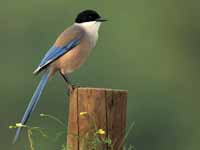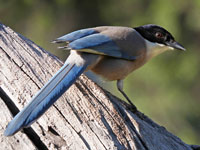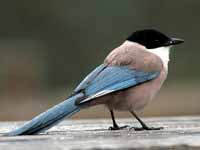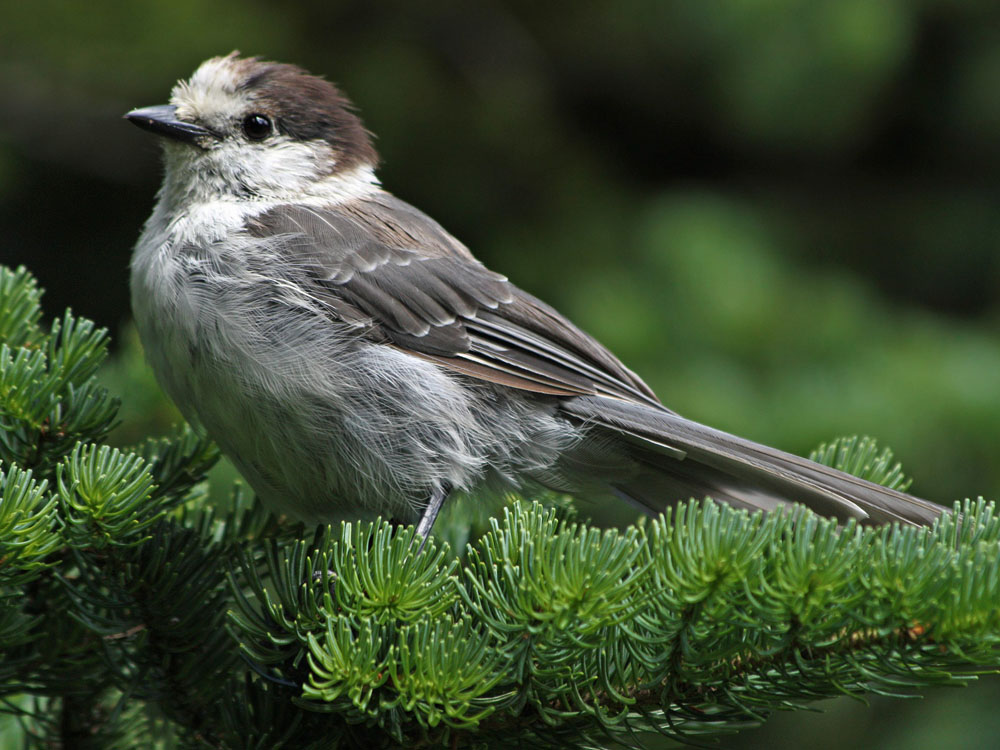THE WORLD BIRDS - An Online Bird Book
CORVIDAE
Subfamily Perisoreinae - Grey Jays and Allies
CORVIDAE
The Corvidae family contains the crows, ravens, rooks, jackdaws, jays, magpies, treepies, choughs and nutcrackers. These species are grouped into subfamilies that are outlined in the table that follows. Beware that names such as jays, magpies, or treepies are not always assigned in a consistant manner. For example, the black magpie (Platysmurus leucopterus) belongs to the treepie subfamily.
| SUBFAMILY | MEMBERS |
| Corvinae | True crows of genus Corvus includes the crows, ravens, rooks, jackdaws. |
| Corvinae (continued) | Jays of genus Garrulus, nutcrackers of Nucifraga, magpies of Pica, ground-jays of Jay Podoces, and the piapiac of Ptilostomus, and Stresemann's bush-crow of Zavattariornis. |
| Cissinae | Green-magpies of Cissa and the blue-magpies of Urocissa. |
| Cyanocoracinae | Most of the species that are named "jay". |
| Crypsirininae | Treepies |
| Perisoreinae | Three jay species of Perisoreus and Magpies of Cyanopica |
Corvids are medium to large in size, with strong feet and bills, and a single moult each year (most passerines moult twice). Most species have bristle-like feathers covering their nostrils. They are omnivores having a varied diet of animal and plant material. Makes average slightly heavier than females. Corvids are found worldwide except for the tip of South America and the polar ice caps.
Subfamily Perisoreinae - Grey Jays and Allies
The grey jays of genus Perisoreus and the magpies of genus Cyanopica are distinctly different in appearance, but they are more closely related to each other that to jays and magpies of other genera. That said, they are jay-like in many of their characteristics. They have cup-like nests made out of twigs, and lined with softer material. They are omnivores eating nuts, seeds, insects and other small animals. The magpies of this covid subfamily are cooperative breeds, the grey-jays are not.
All three grey-jay species store food and live year-round on permanent territories in northern coniferous forests. They do not migrate to survive the cold winters, but manage by eating food previously stored. Also their prefered habitat is comprised of dense conifers such as spruce that provides shelter from the winter winds. Even though it is very cold, they lay their eggs by early March which gives the chicks a longer growing period before the next cold winter. Although some don't make it, their evolution has concluded that not migrating has fewer casualties thah flying south.
The two magpies with long tails are typical magpie in appearance, but are more closely related to the jays of genus Perisoreus than they are to the magpies of genera Cissa, Pica, or Urocissa.
Genus Perisoreus
Jay,_Canada Perisoreus canadensis
Description: The Canada jay, also known as the grey jay, has dark grey upperparts, dark rear of the head, and light grey underparts. The fore-crown, neck, and upper breast are pale grey. It has a small black bill and black legs. The long tail is medium grey with lighter tips. It is 30 to 35 cm long and weighs about 65 grams. The male is the main builder of the nest using twigs, bark, and lichen. The female incubates the eggs. The similar Clark's nutcracker has black on the wings, the Canada jay does not. Also the Canada jay has a dark nape while Clark's Nutcracker has a light colored nape.
Range: North America mainly in Canada and Alaska.
Habitat: Coniferous forests such as spruce and fir; also mixed coniferous- eciduous forests. A key habitat requirements may be sufficiently cold temperatures to ensure successful storage of perishable food.
Diet: They are omnivores eating insects, rodents, chicks, carrion, seeds, berries, fungi. They will also take handouts from humans. They cache food in the summer in hundreds of sites for retrieval during the winter.
Conservation status: Least Concern.
Image by: 1, 2, 3) Dick Daniels - Wonder Lake, Denali National Park 4) Cephas - Quebec, CanadaRange: North America mainly in Canada and Alaska.
Habitat: Coniferous forests such as spruce and fir; also mixed coniferous- eciduous forests. A key habitat requirements may be sufficiently cold temperatures to ensure successful storage of perishable food.
Diet: They are omnivores eating insects, rodents, chicks, carrion, seeds, berries, fungi. They will also take handouts from humans. They cache food in the summer in hundreds of sites for retrieval during the winter.
Conservation status: Least Concern.
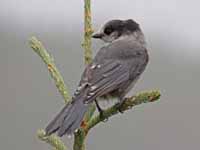



Jay,_Siberian Perisoreus infaustus
Description: The Siberian jay is a very inquisitive and fearless species, which can be seen near camps, and which will take food if some is left nearby. It has greyish-brown upperparts, dark brown head, paler forehead, and buff underparts. The Siberian jay is approximately 30 cm long and 80 grams. Both pair collect nest material, only the female builds the nest, and she also incubates the eggs.
Range: Northern Asia and northern Europe.
Habitat: Dense mature forests with a preference for spruce. Being non-deciduous and dense, spruce blocks cold winter winds.
Diet: Mainly berries, seeds, insects and spiders.
Conservation status: Least Concern.
Image by: 1) Daniel Pettersson 2) Martha de Jong-Lantink 3, 4) Estormiz - FinlandRange: Northern Asia and northern Europe.
Habitat: Dense mature forests with a preference for spruce. Being non-deciduous and dense, spruce blocks cold winter winds.
Diet: Mainly berries, seeds, insects and spiders.
Conservation status: Least Concern.
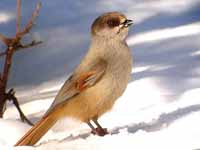
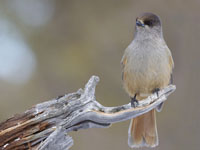
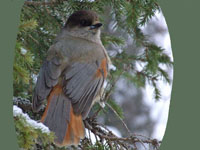

Jay,_Sichuan Perisoreus internigrans
Description: The Sichuan jay has mainly grey plumage with a black head. The small bill is pale. It is about 30 cm long and 110 grams. Like the other members of Perisonreus, the Sichuan jay does not migrate. It survives the cold winters by eating food it previously stored.
Range: Northern China.
Habitat: Coniferous forests.
Diet: Seeds, berries, insects.
Conservation status: The Sichuan jay is listed as Vulnerable because they range is fragmented and they are only seen rarely.
Image by:
1) Unknown Range: Northern China.
Habitat: Coniferous forests.
Diet: Seeds, berries, insects.
Conservation status: The Sichuan jay is listed as Vulnerable because they range is fragmented and they are only seen rarely.
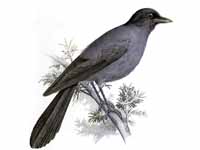
Genus Cyanopica
Magpie,_Azure-winged Cyanopica cyanus
Description: The Azure-winged Magpie has glossy a black head, light grey back, blue wings, and long blue graduated tail with a white tip. Juveniles lack the white at the end of the tail. The underparts including the throat are whitish. white throat. It is 31 to 38 cm long with up to 20 cm of that due to its very long tail. Helpers often participate in nest construction and supply of food for the chicks. The female parent is the sole incubator. It used to be treated as conspecific with the Iberian magpie, but their ranges are widely seperated and there is substanial DNA difference.
Range: Eastern Asia.
Habitat: Wooded areas but not dense forest.
Diet: Acorns, pine seeds., fruit, insects
Conservation status: Least Concern.
Image by: 1) Toshihiro_Gamo - Japan1) 2) Dick Daniels - Woodland Park Zoo, Seattle 3, 4)
Darren Bellerby - Hong Kong Range: Eastern Asia.
Habitat: Wooded areas but not dense forest.
Diet: Acorns, pine seeds., fruit, insects
Conservation status: Least Concern.
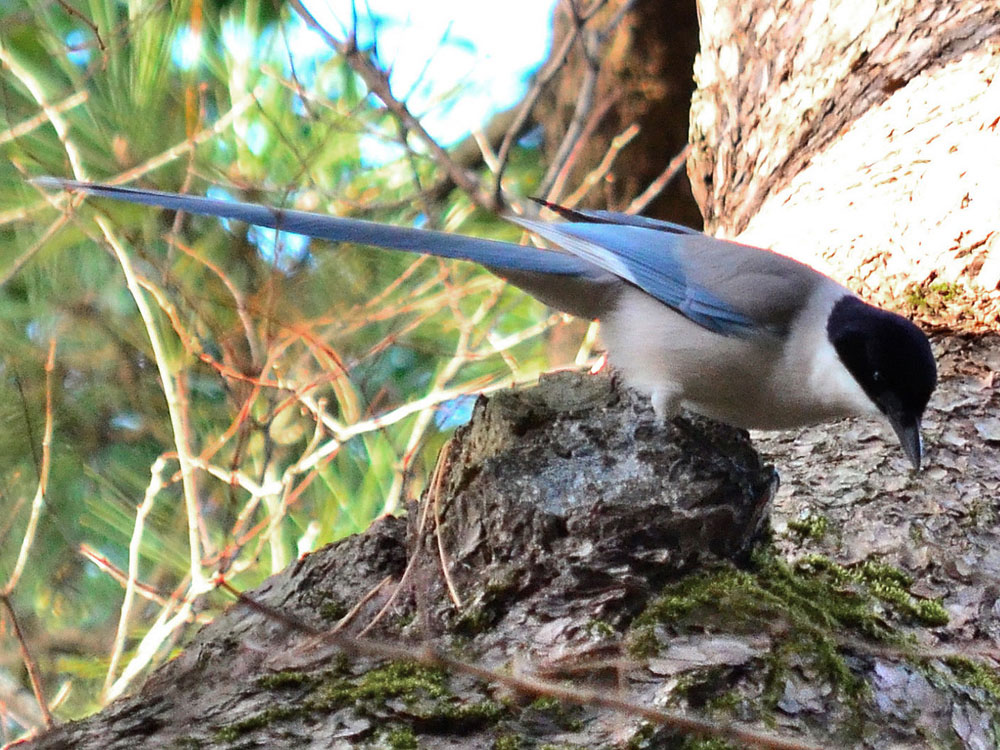

Magpie,_Iberian Cyanopica cooki
Description: The Iberian-winged magpie has a glossy black head, light grey back, blue wings and blue tail top. The underparts including the throat are whitisih including the throat. It is 31 to 38 cm long with up to 20 cm of that due to its very long tail. Helpers often participate in nest construction and supply of food for the chicks.It used to be treated as conspecific with the azure-winged magpie, but their ranges are widely separated and there is substantial DNA difference.
Range: Portugal, Spain.
Habitat: Wooded areas but not dense forest. Prefers oak and pine habitat.
Diet: Acorns, pine seeds., fruit, insects.
Conservation status: Least Concern.
Image by: 1) Agustín Povedano 2) Martien_Brand 3) Frank_Vassen 4) Cristiano Crolle - SpainRange: Portugal, Spain.
Habitat: Wooded areas but not dense forest. Prefers oak and pine habitat.
Diet: Acorns, pine seeds., fruit, insects.
Conservation status: Least Concern.
